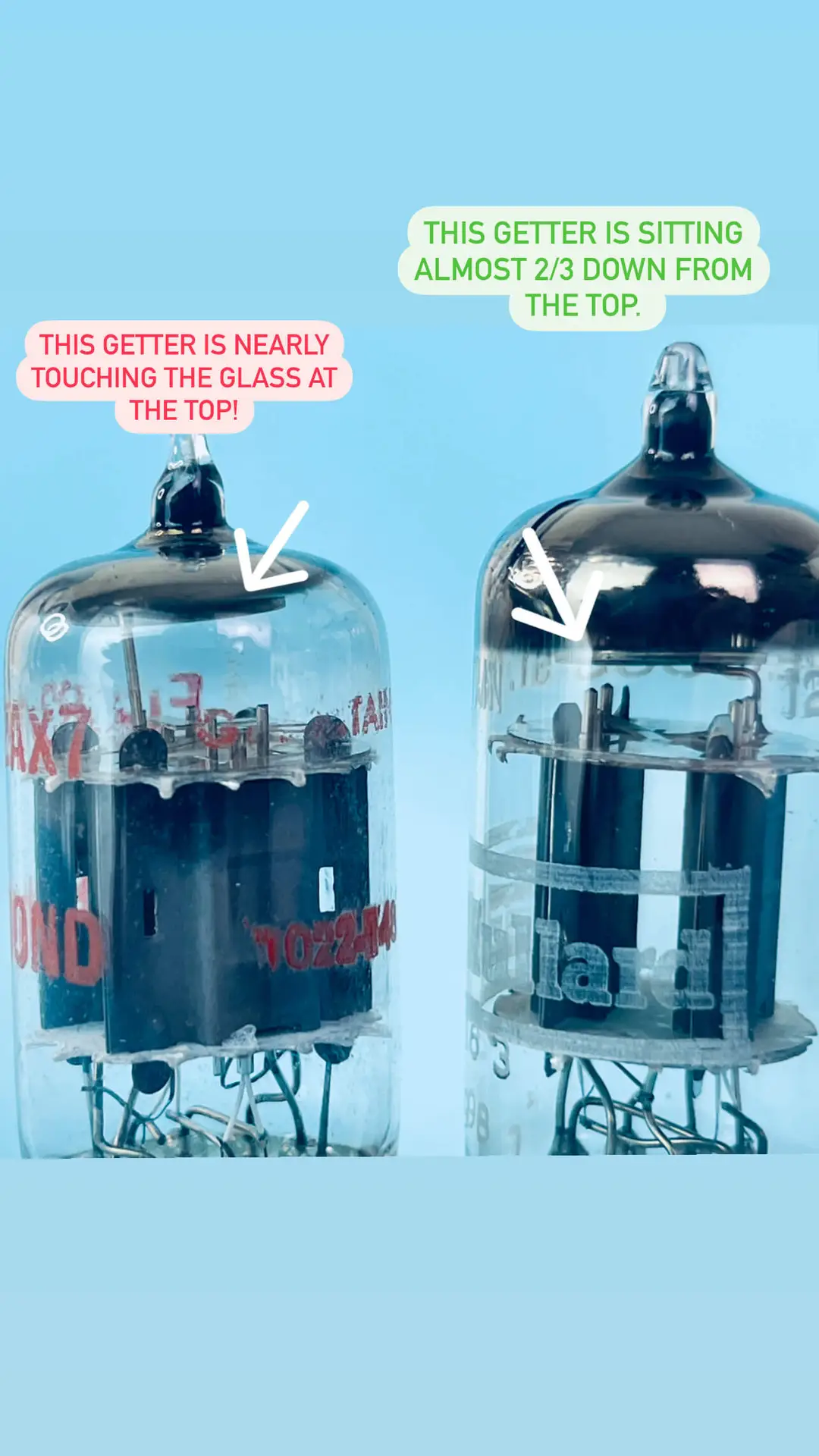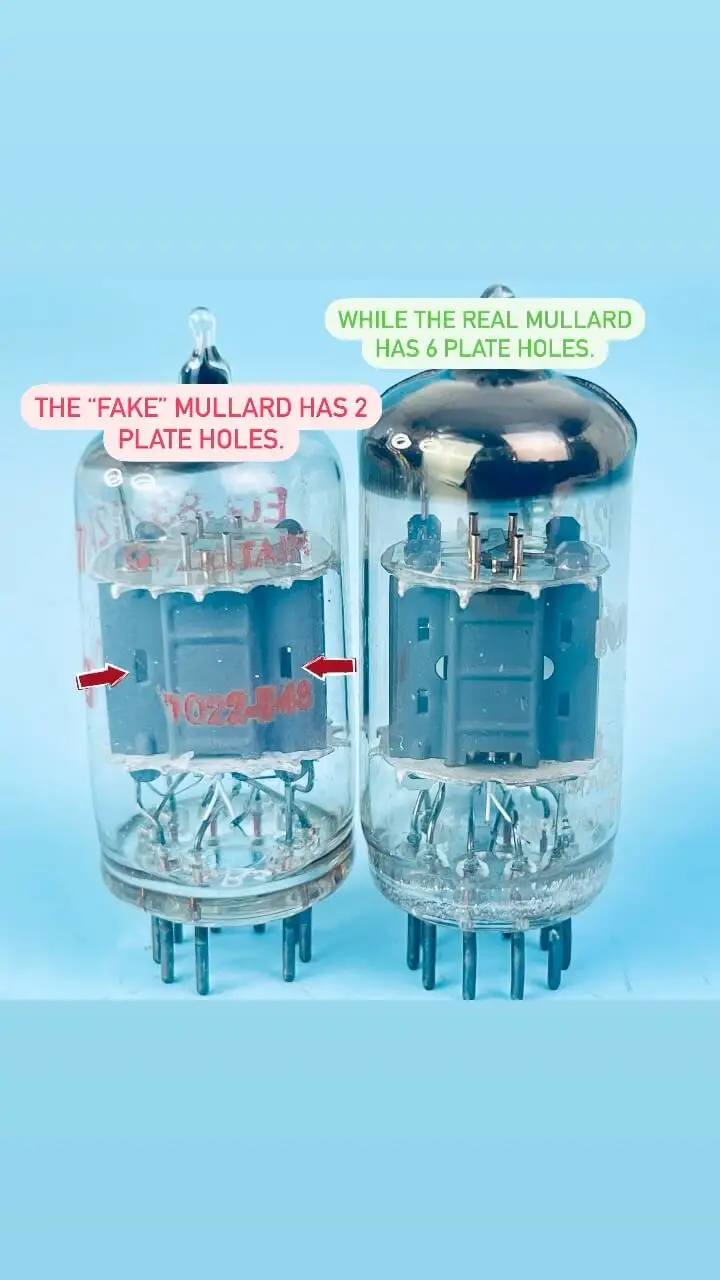It doesn’t happen often but this week we got burned on some fake Mullard tubes!
We are sharing our experience not only to save folks from this happening to them, but also because we had a horrible experience talking with the seller “Treasure Cove Paradise.” This kind of interaction is exactly why we started Fuzz Audio in the first place, so we think it is worth sharing.
We typically don’t buy tubes from eBay, but when we saw a listing for 3 testing strong Mullard 12AX7 for $100, curiosity got the better of us and we pounced. Silly us.

[red flag] The label was created 19 days after we placed the order. Never a good sign when you see that, but we understand life happens and everyone gets busy. Luckily, we have no shortage of tubes and we were able to wait.
Unfortunately, the real fun started once the tubes finally arrived (nearly a month later).
[red flag] When we opened the box, we found a ball of bubble wrap, and at the center were our three tubes mashed together in a sandwich bag, glass on glass. Because we were not planning on making a post about this experience, we did not snap a photo, but it sure was worthy of one.
[red flag] Once we were able to remove the mess of tape and bubble wrap, we finally discovered that these were not Mullard 12AX7s, but were instead Japanese Mullard clones! While we are running low on Japanese 12AX7, we would not have paid what we did, as we normally buy these tubes in bulk. Nothing against Japanese tubes as they are awesome quality valves.
Despite the mistake, we tested them, and they tested great! Fortunately they survived their journey even though the sellers packing left much to be desired. Packing tubes isn’t always easy, especially when you don’t have nifty packing like us…
Finally, we reached out the buyer to let him know these were not indeed Mullard 12AX7 but instead Japanese Mullard clones and asked for a partial or full refund.
[red flag] The seller was immediately accusatory and responded with this gem: “Nothing wrong with these tubes. You also used hate speech and discriminatory language against Japanese. I do not wish to do business or speak to you again.”
After making such a statement, I went back to see what I said. I myself am fairly sensitive to discriminatory language of any kind. We referred to the tube as a “Japanese fake.” Was that it?
I responded, telling him that the tubes were made in Japan, not England. He sarcastically questioned our geographical knowledge by querying, “Great Britain is in Japan? Please give me proof these are from Japan. Hammond and Great Britain is written on them. Nowhere does it read Japan.”
At that point, I took this as a learning opportunity and thought I would take the time to explain why they were indeed Japan made.
I sent him photos of a variety of tubes to try to explain how the plates and type of getter are slightly different. I further explained that true Mullard tubes have “B” codes for Blackburn, England. All three of these tubes are missing a “B” code. And lastly, I shared that real Mullard tubes say “Made in Great Britain,” not “GT Britain.”
Ultimately, although his eBay photos were poor and none of the photos showed the “GT Britain” text, which is a giveaway for a fake, we do think he simply made an honest mistake, rather than have knowingly advertised Japanese tubes as Mullards.
But here is where our frustration comes in. This seller is unwilling to give us a refund, a partial refund or anything of the sort. The seller was incredibly rude, insulting, and accusatory. [red flags] As a buyer, we just wanted to make sure we got what we were paying for, and clearly we were not on the same page. After taking the time to explain our position (and by extension making him a more educated seller), the seller remained unwilling to work toward a mutually agreeable resolution.
The seller, “Treasure Cove Paradise” instead doubled down and told us that he had “sold these to others with no complaints.” There are tens of thousands of these tubes out there that are mismarked with “GT Britain” and it is irresponsible to pass them off as true Mullard tubes. Not all “GT Britain” marked tubes are super nice Japanese Mullard clones either. We have many fake Russian tubes with the “GT Britain” designation as well, and passing these tubes off as Mullards knowingly would be a scam.
Let our experience here be a lesson to all and maybe this is a good time to check your Mullards to make sure they do indeed say “Made in Great Britain” and have “B” codes.
Unfortunately, with vintage tube buying, you need to either have a source you trust or know what you are doing. This is the issue with buying tubes on eBay. There is not much accountability and the process can be frustrating. Here at Fuzz Audio, we strive to do things differently, and our customers are at the heart of what we do. We want to educate our customers in the process so you can really enjoy your gear and be rest assured that you are working with a company you can trust.


In summary, let’s talk about a few things that make these tubes “Japanese Fakes.” This is a harsh way to put it, but they were fake and were stamped with “GT Britain” to mislead the consumer into thinking this was made in the UK when it wasn’t. It could have even been Mullard themselves who did this, but it doesn’t make it a “real” Mullard tube. You know… the tubes that typically sell for $100/piece, not $100 for 3… and that’s on us.
1. The “B” code — the “B” code is the Mullard factory code for Blackburn, England. As far as we know, the Blackburn factory is the only Mullard factory in England that manufactured 12AX7. If you have one Mullard tube missing a “B” code it could just have been rubbed off. But if you have 3 mint tubes and all three are missing the Blackburn code, it is very unlikely that they are authentic. Furthermore, “B” codes are often etched into the glass so they should always be slightly visible. If your tube does not have a “B” code you need to check for other signs of authenticity.
2. The “Change Code” — all Mullard tubes at one point received what is called a “change code.” This code was used to designate various changes Mullard made in their tube designs, as well as acted as a date code. For instance, F91 is a long plate 12AX7 variation, and the F92 long plate eventually replaced the F91 and so on. People collect tubes based off this code frequently as it is a way to follow the history of the Mullard 12AX7.
3. Plate width and staple type — it’s hard to see in photos, but Japanese Mullard clones have slightly wider plates and different shaped staple holes. We have seen so many tubes we that can immediately tell which are authentic Mullards form those that are clones based on plate alone. This is a more advanced method of determining manufacturer.
4. Getter Type — again not the easiest way to tell a tube is authentic for a novice, but a Mullard tube WILL NEVER HAVE A GETTER AT 45 degrees. Only, Matsushita clones have getters that come off at 45 degrees from the top spacer mica. Unfortunately, in the case of these tubes, they have the typical getter style that Blackburn Mullards also have, where the getter is parallel with the mica. Yet, if you look very closely, you can see the Japanese getter is slightly taller. The devil is in the details!